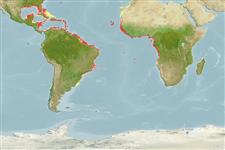Common names from other countries
>
Eupercaria/misc (Various families in series Eupercaria) >
Gerreidae (Mojarras)
Etymology: Eucinostomus: Greek, eu = good + Greek, kyon = dog + Greek, stoma = mouth (Ref. 45335).
More on author: Bleeker.
Environment: milieu / climate zone / depth range / distribution range
Sinh thái học
Biển; Nước ngọt; Thuộc về nước lợ gần đáy; sống cả ở nước ngọt và nuớc mặn (Ref. 51243); Mức độ sâu 0 - 25 m (Ref. 2683). Subtropical; 33°N - 34°S, 98°W - 14°E
Eastern Atlantic: west African coast, from Senegal to Angola (Ref. 57394). Also reported from Mauritania (Ref. 5377, 7352). Western Atlantic: Bermuda and Florida, USA to Brazil; not found in the Bahamas (Ref. 7251).
Bộ gần gũi / Khối lượng (Trọng lượng) / Age
Maturity: Lm ? range ? - ? cm
Max length : 30.0 cm TL con đực/không giới tính; (Ref. 2683); common length : 23.0 cm TL con đực/không giới tính; (Ref. 2683); Khối lượng cực đại được công bố: 26.50 g (Ref. 118626)
Các tia vây lưng cứng (tổng cộng) : 9; Các vây lưng mềm (tổng cộng) : 10; Tia cứng vây hậu môn: 3; Tia mềm vây hậu môn: 7 - 8. Diagnosis: body fusiform and compressed; snout pointed; mouth strongly protrusible; nostrils contiguous, positioned nearer to eye than to snout tip; dorsal fin deeply notched; tips of pectoral fins not reaching to anal-fin origin; scales cycloid on head and finely ctenoid on body; scales of interocular space reaching anterior border of eyes; tip of spinous dorsal fin with a black spot, underlined by a whitish band (Ref. 57394).
Coloration: back olivaceous, sides silvery; a characteristic black spot at tip of spiny part of dorsal fin; young individuals may show dark vertical bars on back and sides (Ref. 57394).
A coastal species entering estuaries, lower courses of coastal rivers, and lagoons (Ref. 4323, 7352, 57394). Found over sand or mud bottoms (Ref. 3722, 57394). Feeds on fish, shrimps, mollusks, zooplankton and detritus (Ref. 28587); including other benthic crustaceans and polychaetes. Forages at daytime in small groups, hovering close to the bottom and either picks off prey on the substrate or digs into it sifting the mouthed sediment through its opercular openings. Its conspicuous black tip on dorsal fin is mimicked by juvenile guianan snooks, Centropomus mexicanus, an example of aggressive mimicry (Ref. 43465). Marketed fresh but not highly esteemed (Ref. 3722).
Life cycle and mating behavior
Maturities | Sự tái sinh sản | Spawnings | Egg(s) | Fecundities | Ấu trùng
Roux, C., 1990. Gerridae. p. 781-782. In J.C. Quero, J.C. Hureau, C. Karrer, A. Post and L. Saldanha (eds.) Check-list of the fishes of the eastern tropical Atlantic (CLOFETA). JNICT, Lisbon; SEI, Paris; and UNESCO, Paris. Vol. 2. (Ref. 7352)
IUCN Red List Status (Ref. 130435)
CITES (Ref. 128078)
Not Evaluated
Threat to humans
Harmless
Human uses
Các nghề cá: buôn bán nhỏ
Các công cụ
Special reports
Download XML
Các nguồn internet
Estimates based on models
Preferred temperature (Ref.
115969): 23.4 - 28, mean 27.1 (based on 1079 cells).
Phylogenetic diversity index (Ref.
82804): PD
50 = 0.5010 [Uniqueness, from 0.5 = low to 2.0 = high].
Bayesian length-weight: a=0.01047 (0.00829 - 0.01322), b=3.08 (3.04 - 3.12), in cm Total Length, based on LWR estimates for this species (Ref.
93245).
Mức dinh dưỡng (Ref.
69278): 3.2 ±0.45 se; based on food items.
Thích nghi nhanh (Ref.
120179): Chiêù cao, thời gian nhân đôi của chủng quần tối thiểu là dưới 15 tháng (Preliminary K or Fecundity.).
Fishing Vulnerability (Ref.
59153): Low vulnerability (20 of 100).
